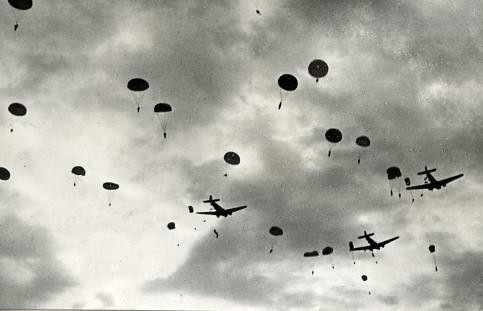| |
|
 |
| Vliegtuigen en parachutisten boven Kreta |
by Nationaal Archief on Flickr |
|
World War II was a global military conflict lasting from 1939 to 1945 which involved most of the world's nations. All of the great powers were organised into two opposing military alliances:
It was the most widespread war in history, with more than 100 million military personnel mobilized.
|
 |
| D-Day: The Normandy Invasion |
by The U.S. Army on Flickr |
|
- War is considered to have begun on 1 September 1939, with the invasion of Poland by Germany and subsequent declarations of war on Germany by France and most of the countries of the British Empire and Commonwealth.
- Many countries were already at war by this date, such as Ethiopia and Italy in the Second Italo-Abyssinian War and China and Japan in the Second Sino-Japanese War.
- Many that were not initially involved joined the war later in response to events such as the German invasion of the Soviet Union and the Japanese attacks on the U.S. Pacific Fleet at Pearl Harbor and on British overseas colonies
- This triggered declarations of war on Japan by the United States, the British Commonwealth and the Netherlands.
|
- On 1 September 1939, Germany and Slovakia — a client state in 1939 — attacked Poland. France, Britain, and the countries of the Commonwealth declared war on Germany but provided little military support to Poland other than a small French attack into the Saarland.
- On 17 September 1939, after signing an armistice with Japan, the Soviets launched their own invasion of Poland. By early October, Poland was divided among Germany, the Soviet Union, Lithuania and Slovakia, although Poland never officially surrendered and continued the fight outside its borders.
- At the same time as the battle in Poland, Japan launched its first attack against Changsha, a strategically important Chinese city, but was repulsed by late September.
|
 |
| D-Day: The Normandy Invasion |
by The U.S. Army on Flickr |
|
- Following the invasion of Poland and a German-Soviet treaty governing Lithuania, the Soviet Union forced the Baltic countries to allow it to station Soviet troops in their countries under pacts of "mutual assistance.
- Finland rejected territorial demands and was invaded by the Soviet Union in November 1939.
- The resulting conflict ended in March 1940 with Finnish concessions.
- France and the United Kingdom, treating the Soviet attack on Finland as tantamount to entering the war on the side of the Germans, responded to the Soviet invasion by supporting the USSR's expulsion from the League of Nations.
- In June 1940, the Soviet Armed Forces invaded and occupied the neutral Baltic States .
|
- Germany was responsible for 'The Holocaust' the killing of approximately 6 million Jews as well as 2 million ethnic Poles and 4 million other as part of a programme of deliberate extermination.
- About 12 million, most of whom were Eastern Europeans, were employed in the German war economy as forced laborers.
|
 |
| M-4 tank line, Ft. Knox, Ky. (LOC) |
by The Library of Congress on Flickr |
|
- In April 1940, Germany invaded Denmark and Norway to secure shipments of iron ore from Sweden.
- The Axis expanded in November 1940 when Hungary, Slovakia, and Romania joined the Tripartite Pact.
- In October 1940, Italy invaded Greece but within days was repulsed and pushed back into Albania, where a stalemate soon occurred.
- In December 1940, British Commonwealth forces began counter-offensives against Italian forces in Egypt and Italian East Africa
|
 |
| philippines |
by The U.S. Army on Flickr |
|
Marked by significant action against civilians, including the Holocaust and the only use of nuclear weapons in warfare, it was the deadliest conflict in human history, with over seventy million casualties.
|
 |
| What does liberation look like? |
by The National Archives UK on Flickr |
|
- The war ended with the victory of the Allies in 1945, leaving the political alignment and social structure of the world significantly changed.
- United Nations was established to foster international cooperation and prevent future conflicts
- Soviet Union and the United States emerged as rival super-powers, setting the stage for Cold War, which lasted for the next 46 years.
- Meanwhile, the acceptance of the principle of self-determination accelerated decolonization movements in Asia and Africa, while Western Europe began moving toward economic recovery and increased political integration.
|
 NeoK12.com - Educational Videos, Lessons, Quizzes & Presentations
NeoK12.com - Educational Videos, Lessons, Quizzes & Presentations




